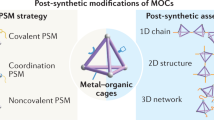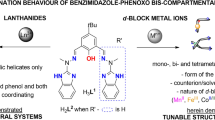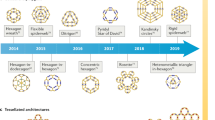Abstract
Metal–organic polyhedra—discrete molecular architectures constructed through the coordination of metal ions and organic linkers—have recently attracted considerable attention due to their intriguing structures, their potential for a variety of applications and their relevance to biological self-assembly. Several synthetic routes have been investigated to prepare these complexes. However, to date, these preparative methods have typically been based on the direct assembly of metal ions and organic linkers. Although these routes are convenient, it remains difficult to find suitable reaction conditions or to control the outcome of the assembly process. Here, we demonstrate a synthetic strategy based on the substitution of bridging ligands in soluble metal–organic polyhedra. The introduction of linkers with different properties from those of the initial metal–organic polyhedra can thus lead to new metal–organic polyhedra with distinct properties (including size and shape). Furthermore, partial substitution can also occur and form mixed-ligand species that may be difficult to access by means of other approaches.
This is a preview of subscription content, access via your institution
Access options
Subscribe to this journal
Receive 12 print issues and online access
$259.00 per year
only $21.58 per issue
Buy this article
- Purchase on Springer Link
- Instant access to full article PDF
Prices may be subject to local taxes which are calculated during checkout





Similar content being viewed by others
References
Olenyuk, B., Whiteford, J. A., Fechtenkötter, A. & Stang, P. J. Self-assembly of nanoscale cuboctahedra by coordination chemistry. Nature 398, 796–799 (1999).
Takeda, N., Umemoto, K., Yamaguchi, K. & Fujita, M. A nanometre-sized hexahedral coordination capsule assembled from 24 components. Nature 398, 794–796 (1999).
Hof, F. & Rebek, J. Jr. Molecules within molecules: recognition through self-assembly. Proc. Natl Acad. Sci. USA 99, 4775–4777 (2002).
Pluth, M. D., Bergman, R. G. & Raymond, K. N. Acid catalysis in basic solution: a supramolecular host promotes orthoformate hydrolysis. Science 316, 85–88 (2007).
Lehn, J.-M. From supramolecular chemistry towards constitutional dynamic chemistry and adaptive chemistry. Chem. Soc. Rev. 36, 151–160 (2007).
Koblenz, T. S., Wassenaar, J. & Reek, J. N. H. Reactivity within a confined self-assembled nanospace. Chem. Soc. Rev. 37, 247–262 (2008).
Lee, S. J. et al. Cavity-tailored, self-sorting supramolecular catalytic boxes for selective oxidation. J. Am. Chem. Soc. 130, 16828–16829 (2008).
Jung, M., Kim, H., Baek, K. & Kim, K. Synthetic ion channel based on metal–organic polyhedra. Angew. Chem. Int. Ed. 47, 5755–5757 (2008).
Mal, P., Breiner, B., Rissanen, K. & Nitschke, J. R. White phosphorus is air-stable within a self-assembled tetrahedral capsule. Science 324, 1697–1699 (2009).
Sawada, T., Yoshizawa, M., Sato, S. & Fujita, M. Minimal nucleotide duplex formation in water through enclathration in self-assembled hosts. Nature Chem. 1, 53–56 (2009).
Ronson, T. K. et al. Stellated polyhedral assembly of a topologically complicated Pd4L4 ‘Solomon cube’. Nature Chem. 1, 212–216 (2009).
Stoddart, J. F. Thither supramolecular chemistry. Nature Chem. 1, 14–15 (2009).
Duriska, M. B. et al. Systematic metal variation and solvent and hydrogen-gas storage in supramolecular nanoballs. Angew. Chem. Int. Ed. 48, 8919–8922 (2009).
Caulder, D. L. & Raymond, K. N. Supermolecules by design. Acc. Chem. Res. 32, 975–982 (1999).
Leininger, S., Olenyuk, B. & Stang, P. J. Self-assembly of discrete cyclic nanostructures mediated by transition metals. Chem. Rev. 100, 853–908 (2000).
Fujita, M. et al. Molecular paneling via coordination. Chem. Commun. 509–518 (2001).
McKinlay, R. M., Cave, G. W. V. & Atwood, J. L. Supramolecular blueprint approach to metal-coordinated capsules. Proc. Natl Acad. Sci. USA 102, 5944–5948 (2005).
Gianneschi, N. C., Maser, M. S. & Mirkin, C. A. Development of a coordination chemistry-based approach for functional supramolecular structures. Acc. Chem. Res. 38, 825–837 (2005).
Tranchemontagne, D. J., Ni, Z., O'Keeffe, M. & Yaghi, O. M. Reticular chemistry of metal–organic polyhedra. Angew. Chem. Int. Ed. 47, 5136–5147 (2008).
Hamilton, T. D., Papaefstathiou, G. S., Friščić, T., Bučar, D.-K. & MacGillivray, L. R. Onion-shell metal–organic polyhedra (MOPs): a general approach to decorate the exteriors of MOPs using principles of supramolecular chemistry. J. Am. Chem. Soc. 130, 14366–14367 (2008).
Ercolani, G. Assessment of cooperativity in self-assembly. J. Am. Chem. Soc. 125, 16097–16103 (2003).
Nitschke, J. R. & Lehn, J.-M. Self-organization by selection: generation of a metallosupramolecular grid architecture by selection of components in a dynamic library of ligands. Proc. Natl Acad. Sci. USA 100, 11970–11974 (2003).
Zheng, Y.-R., Yang, H.-B., Northrop, B. H., Ghosh, K. & Stang, P. J. Size selective self-sorting in coordination-driven self-assembly of finite ensembles. Inorg. Chem. 47, 4706–4711 (2008).
Northrop, B. H., Zheng, Y.-R., Chi, K.-W. & Stang, P. J. Self-organization in coordination-driven self-assembly. Acc. Chem. Res. 42, 1554–1563 (2009).
Li, J.-R. & Zhou, H.-C. Metal–organic hendecahedra assembled from dinuclear paddlewheel nodes and mixtures of ditopic linkers with 120 and 90° bend angles. Angew. Chem. Int. Ed. 48, 8465–8468 (2009).
Fujita, M., Fujita, N., Ogura, K. & Yamaguchik, K. Spontaneous assembly of ten components into two interlocked, identical coordination cages. Nature 400, 52–55 (1999).
Hiraoka, S., Sakata, Y. & Shionoya, M. Ti(IV)-centered dynamic interconversion between Pd(II), Ti(IV)-containing ring and cage molecules. J. Am. Chem. Soc. 130, 10058–10059 (2008).
Al-Rasbi, N. K. et al. Mixed-ligand molecular paneling: dodecanuclear cuboctahedral coordination cages based on a combination of edge-bridging and face-capping ligands. J. Am. Chem. Soc. 130, 11641–11649 (2008).
Zheng, Y.-R. & Stang, P. J. Direct and quantitative characterization of dynamic ligand exchange between coordination-driven self-assembled supramolecular polygons. J. Am. Chem. Soc. 131, 3487–3489 (2009).
Ke, Y., Collins, D. J. & Zhou, H.-C. Synthesis and structure of cuboctahedral and anticuboctahedral cages containing 12 quadruply bonded dimolybdenum units. Inorg. Chem. 44, 4154–4156 (2005).
Abourahma, H. et al. Hydroxylated nanoballs: synthesis, crystal structure, solubility and crystallization on surfaces. Chem. Commun. 2380–2381 (2001).
Li, J.-R., Timmons, D. J. & Zhou, H.-C. Interconversion between molecular polyhedra and metal–organic frameworks. J. Am. Chem. Soc. 131, 6368–6369 (2009).
Eddaoudi, M. et al. Porous metal–organic polyhedra: 25 Å cuboctahedron constructed from 12 Cu2(CO2)4 paddle-wheel building blocks. J. Am. Chem. Soc. 123, 4368–4369 (2001).
Moulton, B., Lu, J., Mondal, A. & Zaworotko, M. J. Nanoballs: nanoscale faceted polyhedra with large windows and cavities. Chem. Commun. 863–864 (2001).
Kristiansson, O. & Tergenius, L.-E. Structure and host–guest properties of the nanoporous diaquatetrakis(p-nitrobenzoato)dicopper(II) framework. J. Chem. Soc. Dalton Trans. 1415–1420 (2001).
Sato, S., Ishido, Y. & Fujita, M. Remarkable stabilization of M12L24 spherical frameworks through the cooperation of 48 Pd(II)–pyridine interactions. J. Am. Chem. Soc. 131, 6064–6065 (2009).
Richens, D. T. Ligand substitution reactions at inorganic centers. Chem. Rev. 105, 1961–2002 (2005).
Puddephatt, R. J. Macrocycles, catenanes, oligomers and polymers in gold chemistry. Chem. Soc. Rev. 37, 2012–2027 (2008).
Bagai, R. & Christou, G. The Drosophila of single-molecule magnetism: [Mn12O12(O2CR)16(H2O)4]. Chem. Soc. Rev. 38, 1011–1026 (2009).
Larsen, R. W. How fast do metal organic polyhedra form in solution? Kinetics of [Cu2(5-OH-bdc)2L2]12 formation in methanol. J. Am. Chem. Soc. 130, 11246–11247 (2008).
Tozawa, T. et al. Porous organic cages. Nature Mater. 8, 973–978 (2009).
Spek, A. L. Single-crystal structure validation with the program PLATON. J. Appl. Crystallogr. 36, 7–13 (2003).
Acknowledgements
This material is based upon work supported as part of the Center for Gas Separations Relevant to Clean Energy Technologies, an Energy Frontier Research Center funded by the U.S. Department of Energy, Office of Science, Office of Basic Energy Sciences under award no. DE-SC0001015. The authors thank A. Yakovenko for his help in crystal structure refinement and PXRD analysis.
Author information
Authors and Affiliations
Contributions
J.R.L. and H.C.Z. conceived and designed the experiments, analysed data and co-wrote the paper. J.R.L. performed all experiments.
Corresponding author
Supplementary information
Supplementary information
Supplementary information (PDF 1735 kb)
Supplementary information
nchem.803-S2.cif Crystallographic data for compound 1 (CIF 28 kb)
Supplementary information
nchem.803-S3.cif Crystallographic data for compound 2 (CIF 27 kb)
Supplementary information
nchem.803-S4.cif Crystallographic data for compound 3 (CIF 32 kb)
Supplementary information
nchem.803-S5.cif Crystallographic data for compound 4 (CIF 88 kb)
Supplementary information
nchem.803-S6.cif Crystallographic data for compound 5 (CIF 47 kb)
Supplementary information
nchem.803-S7.cif Crystallographic data for compound 6 (CIF 58 kb)
Supplementary information
nchem.803-S8.cif Crystallographic data for compound 7 (CIF 47 kb)
Supplementary information
nchem.803-S9.cif Crystallographic data for compound 8 (CIF 41 kb)
Supplementary information
nchem.803-S10.cif Crystallographic data for compound 9 (CIF 53 kb)
Supplementary information
nchem.803-S11.cif Crystallographic data for compound 10 (CIF 17 kb)
Rights and permissions
About this article
Cite this article
Li, JR., Zhou, HC. Bridging-ligand-substitution strategy for the preparation of metal–organic polyhedra. Nature Chem 2, 893–898 (2010). https://doi.org/10.1038/nchem.803
Received:
Accepted:
Published:
Issue Date:
DOI: https://doi.org/10.1038/nchem.803
This article is cited by
-
Non-statistical assembly of multicomponent [Pd2ABCD] cages
Nature Chemistry (2024)
-
Symmetry-breaking host–guest assembly in a hydrogen-bonded supramolecular system
Nature Communications (2023)
-
Enhance gas-separation efficiency of mixed matrix membranes by lamellarly arranged metal-organic polyhedron
Nano Research (2023)
-
Porous metal-organic cage-based membranes
Science China Chemistry (2023)
-
Face-directed Strategy for the Construction of Polyoxovanadate-based Metal-Organic Tetrahedra
Chemical Research in Chinese Universities (2023)



